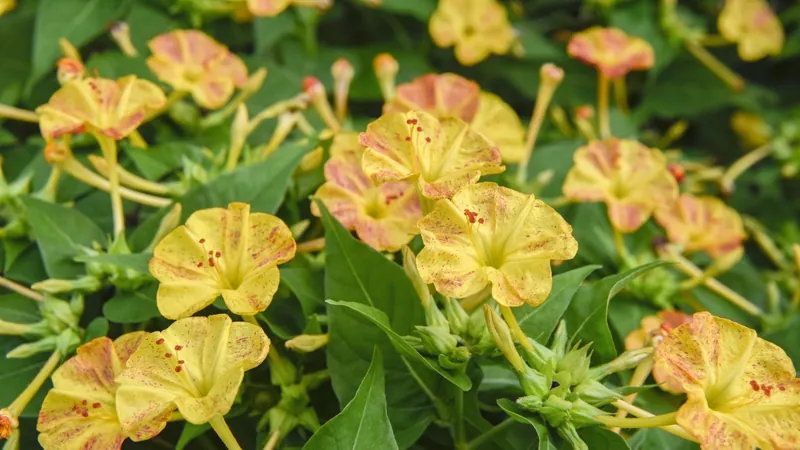
Unlock the Secrets to Thriving Four O'Clock Plants: Your Ultimate Guide
2025-09-14
Author: Jia
Four O’Clocks: Nature’s Evening Spectacle
Four o'clock plants, known scientifically as Mirabilis jalapa, live up to their intriguing name by revealing vibrant, sweet-smelling blooms that burst open late in the afternoon and continue dazzling in the night. Often celebrated as the 'Marvel of Peru,' these captivating flowers hail from the lush Andes of South America.
A Magnet for Pollinators
With a stunning array of colors, four o'clock plants not only beautify gardens but also attract a host of pollinators. From hummingbirds and butterflies flitting about during the day to nocturnal creatures like moths taking center stage at night, these plants create a vibrant ecosystem in any garden.
Start Your Four O’Clock Journey!
Growing four o'clock plants is a breeze! These low-maintenance plants thrive in various climates, making them ideal for flower beds and containers. You can grow them as annuals or dig them up to overwinter in cooler regions, much like dahlias. Let's dive into how to cultivate these enchanting plants.
Sowing Seeds: The First Step
Kickstart your four o'clock journey by sowing seeds in the spring. For a more robust collection, consider propagating established clumps or tubers.
But a word of caution: these plants can be toxic to both humans and pets. If you have curious creatures in your home, think twice before planting!
Germination Secrets Revealed!
Before planting, give your seeds a boost! Scarify the tough outer coating by gently rubbing them with sandpaper or slicing them with a small blade to let water in. After that, soak them in lukewarm water for eight hours to kickstart the germination process.
Timing is Everything
For those in warmer climates, sow your seeds directly in the garden after the last frost. In cooler regions, start them indoors 6-8 weeks before the last frost date. Indoors, place your seeds in a light, well-draining compost and cover lightly. Keep them in a warm spot and watch for seedlings in just 7-14 days!
Outdoor Planting Made Easy
When the soil temperature hits 65°F, it's time to plant outdoors. Sow your seeds a quarter inch deep and at least six inches apart. Lightly cover them and keep the soil moist to encourage germination.
Creating the Perfect Environment
Four o'clocks thrive best in full sun but can tolerate partial shade, needing at least six hours of sunlight daily to flourish. They are adaptable and can grow in various soil types, but well-draining soils are crucial to prevent tuber rot.
Key Maintenance Tips for Vibrant Blooms
Consistency is key when watering four o'clock plants. Ensure the soil is moist, especially during hotter days, but avoid waterlogging. An occasional feeding in spring, followed by a bloom booster mid-summer, will keep your plants healthy, but stop fertilizing in fall to let them prepare for winter.
Regularly pruning young shoots can encourage bushier growth and longer blooming seasons. Plus, deadheading spent flowers keeps your garden looking tidy and may prevent self-seeding.
Wintering Your Plants
If you live in a warmer climate, your four o'clocks can flourish year-round. However, in colder areas, consider bringing the tubers indoors. Just cut them back, store in a dry, cool space, and replant in spring.
Seed Collection: Going Beyond the Bloom
Four o'clocks are self-seeding, allowing for an effortless garden expansion. If you prefer controlling their spread, you can collect seeds before they disperse. Watch for large black seeds at the tips of the stems, and store them for next spring.
Explore the Night Garden
Four o'clock plants not only illuminate the garden with their late blooms but also beckon nocturnal pollinators. For those keen on creating a magical night garden, consider incorporating moonflowers, night-blooming jasmine, and evening primrose for a stunning after-dark showcase.
Your Gardening Toolkit
To assist in your four o'clock journey, consider utilizing soil moisture meters, organic fertilizers, and pruning snips to ensure your plants remain healthy and vibrant.
With these tips in hand, you're ready to cultivate an enchanting array of four o'clock plants that will flourish and delight both you and local wildlife in your outdoor space!



 Brasil (PT)
Brasil (PT)
 Canada (EN)
Canada (EN)
 Chile (ES)
Chile (ES)
 Česko (CS)
Česko (CS)
 대한민국 (KO)
대한민국 (KO)
 España (ES)
España (ES)
 France (FR)
France (FR)
 Hong Kong (EN)
Hong Kong (EN)
 Italia (IT)
Italia (IT)
 日本 (JA)
日本 (JA)
 Magyarország (HU)
Magyarország (HU)
 Norge (NO)
Norge (NO)
 Polska (PL)
Polska (PL)
 Schweiz (DE)
Schweiz (DE)
 Singapore (EN)
Singapore (EN)
 Sverige (SV)
Sverige (SV)
 Suomi (FI)
Suomi (FI)
 Türkiye (TR)
Türkiye (TR)
 الإمارات العربية المتحدة (AR)
الإمارات العربية المتحدة (AR)